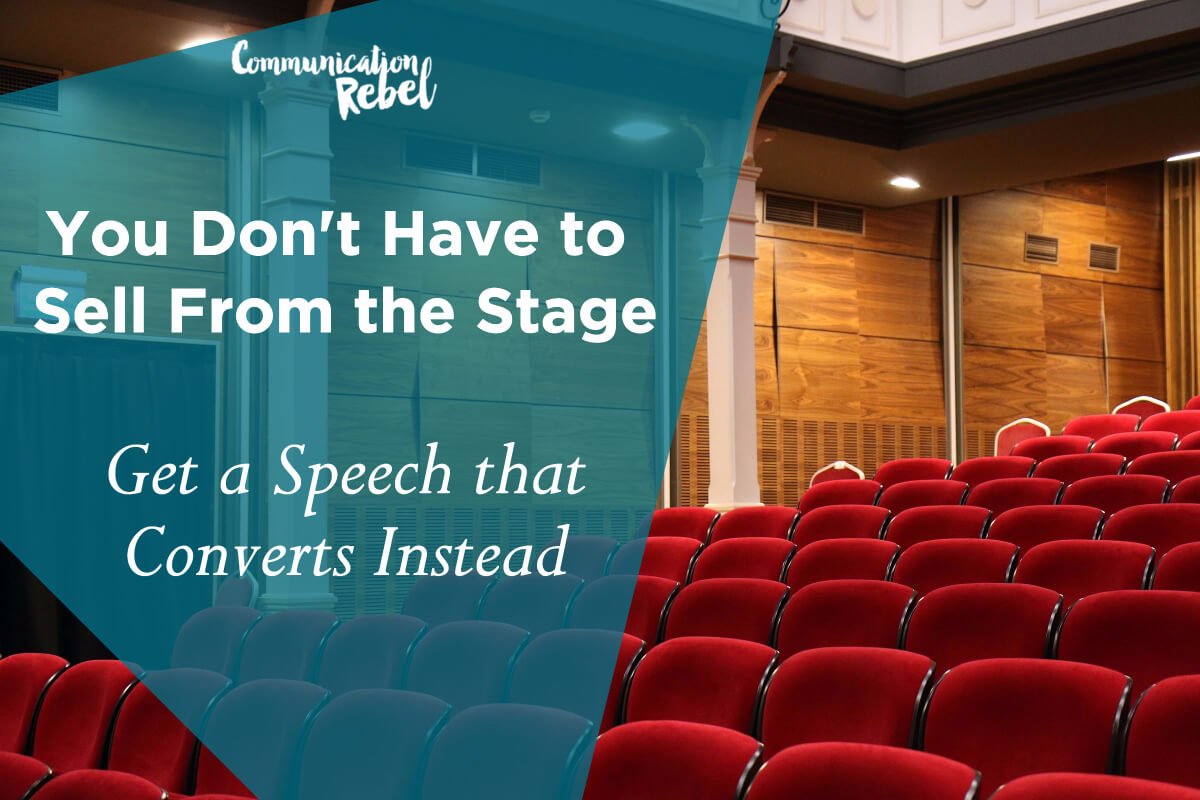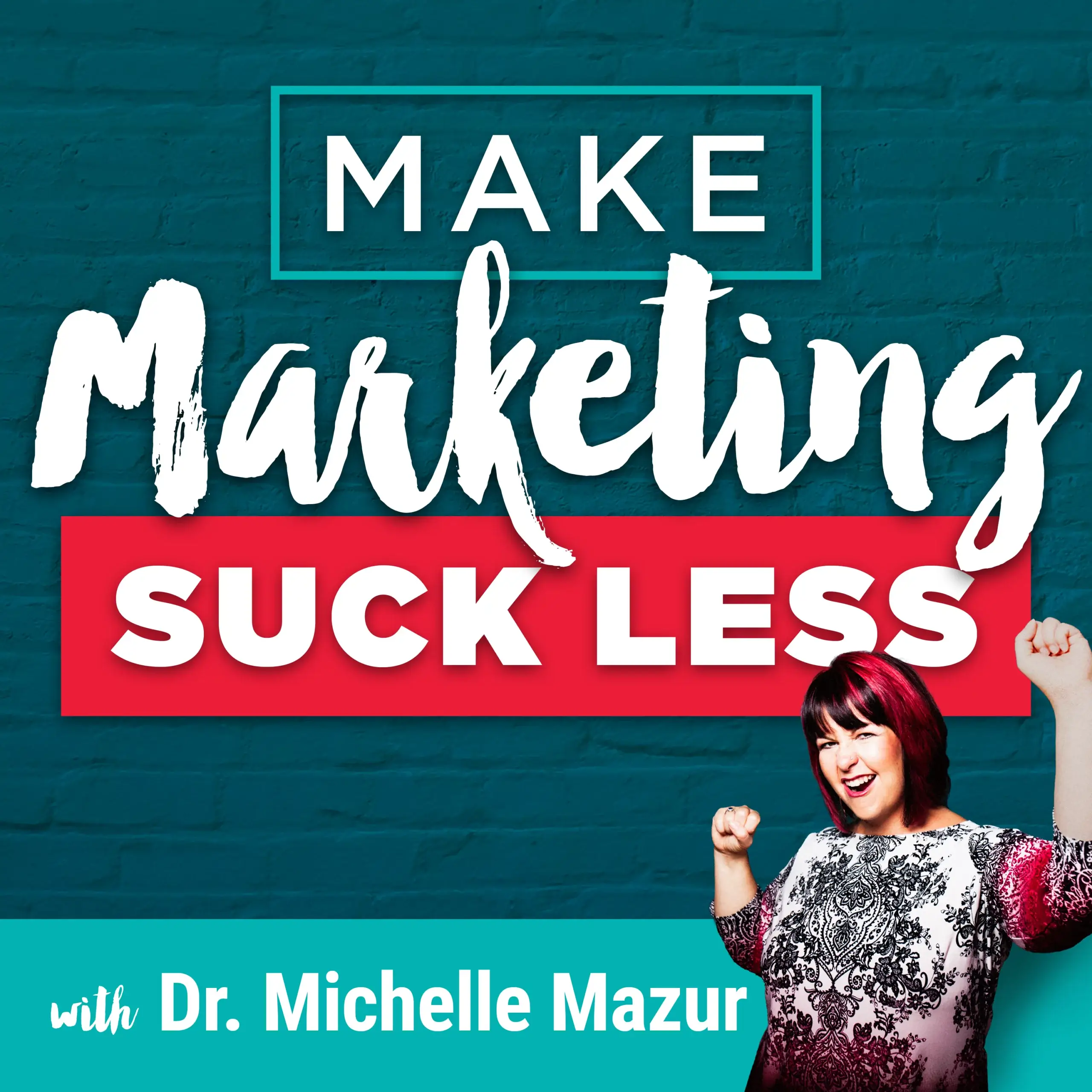Make Marketing Suck Less
You Don’t Have to Sell from the Stage. Get a Speech that Converts Instead
By Michelle Mazur > October 17, 2017
Filed Under Tell Your Story

I'm sure you've been there.
You're watching a speaker, taking notes, you're enjoying it, having an “Aha,” moment or two, and then wham-bam-thank-you-ma'am, the sales pitch comes.
And it feels awkward.
You feel awkward, like you should buy even though you just met this person, and they want you to spend $1,295 for their latest and greatest program.
In your mind, you want to be able to date them first, get to know them a little bit better, because hey, you do like them. But no, this is a one time offer, never to be offered again, run to the back of the room.
And it feels icky for you, it feels high-pressured.
And while some people buy, that's not you. Or maybe it is you; we've all fallen for this once or twice.
But more importantly, that's not the kind of speaker you want to be.
Yes, you want to speak to market your business, to get clients and customers; it's part of how you're getting paid.
But you don't have to be that guy on the stage, you don't have to speak to sell.
You can speak to convert instead.
Prefer to listen?
This speech to convert model is something that I've been working on for the past few years with many of my clients.
It's a different system to get clients and customers into your business. It is quite different from speak to sell, which is what we are talking about today.
Here are 4 ways a speech that converts is different than any of those speak-to-sell formulas out there.
[interact-quiz id=”59b867453e03d90012858222″ w=”600″ h=”500″]
Table of Contents
#1 Focus on Conversions NOT Sales Numbers
So what makes a speech that converts different than speak to sell?
Number one, a speech that converts focuses on conversions, not sales.
That's a big difference. When you are on stage with a speech that converts, you're not selling anything yet.
Instead, a conversion is a desired action that you want the audience to take, and 95% of the time it costs the audience no money to take that action.
This builds trust. Trust leads to sales.
Instead, it's a way to take them deeper into your content, into what you do, and to make sure that what you offer is aligned 100% with what you need.
And the great part is, when you do a speech that converts, you incorporate your existing sales process.
Your call to action should align with your existing sales process.
For example, if you do one-on-one sales, then you should be offering consults in your speech.
If you’ve got a screaming funnel that converts like gangbusters, then give them a lead magnet that gets them into that system.
So the goal with the speech that converts is to build a relationship, and then that relationship leads to a sale, and that's what makes it different.
You want the audience to take the desired action, and the sale comes through your normal sales process.
#2 Give Value to Your Audience First and Always
The second major difference is that a speech that converts focuses on giving value first, and always.
With speak to sell, the goal of the speech is to solve a problem. Then, set up another problem that can only be solved by choosing to work with you.
Whereas in a speech that converts, the purpose is to position yourself as an expert on your topic. This isn’t hard, since you already are an expert because you own a business.
You want to be seen as a thought leader, the person to know, the person to like, the person to trust on this topic.
And does that sound familiar? Know, like, trust? That's the core of persuasion, right? We buy from people we know, like, or trust.
So your speech can set up that environment. And the way that you do that, is by giving value first and always.
There's no awkward transition into a sales pitch. You just focus on what you do best as a speaker; giving value and creating a transformation.
#3 A Speech that Converts is In Line with Your Business
And the final difference between a speech that converts and speak to sell, is that it is 100% aligned with your business and your existing sales process.
When I start working with a speech that converts client, I always want to know what are they selling. That will be the one product.
You'll remember from the last episode, I talked about how your focus should always be on the end or the one product that you want to be selling and promoting with your speaking.
When I work with someone I want to know about that product or service.
I also want to know what their sales process is like.
How long does it take? How many touch points are there? Does it happen all online or is it a high touch sales process? What does that look like?
With a speech that converts, the endpoint of the whole system is your sales process, and this takes place after the event.
But you need to know what you’re offering and the sales process so you can create a speech that actually aligns with it.
So here is the bottom line: Speaking doesn't take the place of your sales process.
I think that's a big mistake with speak to sell models. They move the audience too quickly from that warming up, getting to know you stage, to shouting, “Buy my stuff!”
By using these high-pressure tactics they don't have to do the normal sales process that you would do for someone who just contacted you in your business.
[Tweet “Speaking doesn't take the place of your sales process.”]
#4 A Speech that Converts is 100% No Pressure – No Hype
This brings me to the final difference between a speech that converts and speak to sell. Your speech is 100% free from the high-pressure persuasive techniques that speak to sell uses.
I've written about this, I've talked about this on other podcasts, I have a whole blog post about defense against the dark persuasion arts. If you are a long time reader you already know that I hate how speakers and marketers use these persuasive tactics.
Tactics like scarcity, liking, social proof, micro commitments are all powerful tactics to get people to say yes.
Most of the time, with speak to sell and some other marketing that is taught out in the online world, they are used in a way that is unethical.
Robert Cialdini is the father of these types of tactics. In his wildly popular book, Influence, he has an entire chapter about ethics because these tactics are so powerful. Cialdini talks about when they should be used, and when they shouldn’t.
The ethics of this type of persuasion has been largely ignored by speak to sell gurus.
People shouldn't buy a product or service because they feel pressured to buy it because you're using persuasive techniques. Someone should buy a product or service because it's the best thing for them.
And that is the essence of goodwill in speaking: that we want the best for our audience members.
For some of them, that means working with us, for others that might just mean reading our blogs and subscribing to our podcasts.
But we don't want people to take an action because they feel forced or manipulated into it.
A speech that converts uses persuasion ethically, meaning that it's naturally occurring.
When you've got a speech that converts, you don't need those persuasive techniques for your audience members to become clients, it's going to happen naturally in a way that feels good.
[Tweet “Ethical speakers use speeches that convert not pressure tactics.”]
[interact-quiz id=”59b867453e03d90012858222″ w=”600″ h=”500″]
Until next time, remember, you don't have to sell from the stage to get clients into your business.
You can have a powerful speech that converts people into a relationship with you so that they get to know your work and your business, and then you'll get the sale.
Create Your One-of-a-Kind Message
Your 3 Word Rebellion is the Key to Growing Your Business & Impact






